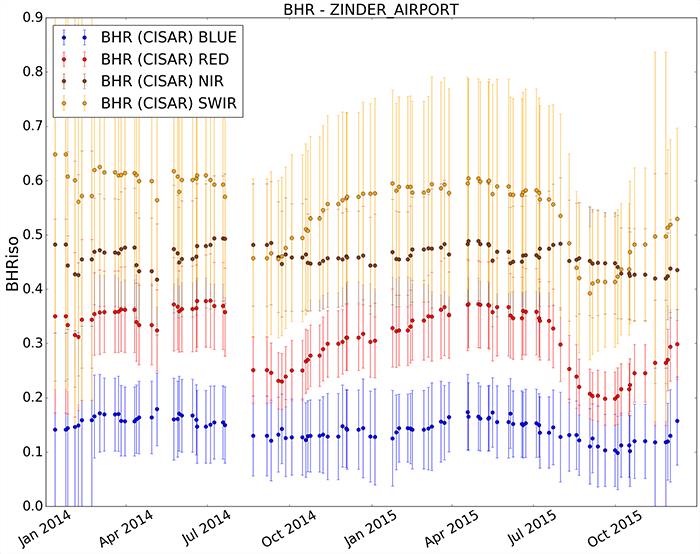Application of the CISAR algorithm on PROBA-V observations
In the context of the ESA PV-LAC project, the Combined Inversion of Surface and AeRosol (CISAR) algorithm has been applied to PROBA-V observations to deliver the surface reflectance in the four PROBA-V bands and the aerosol optical thickness at 0.55μm, together with their associated uncertainty (Luffarelli and Govaerts, 2019).
PROBA-V observations acquired in bands BLUE (0.464 μm), RED (0.655 μm), NIR (0.837 μm) and SWIR (1.603 μm) are accumulated during a period of 16 days. During that period, surface properties, represented by the RPV model ( Rahman et al., 1993) over land surfaces, are assumed invariant. The accumulation period are shifted by 8 days.
The radiometric noise for every observation is estimated considering both the noise of the instrument and the uncertainty related to all the models and assumptions used in the algorithm. Only observations acquired with an illumination and viewing angle smaller than 70° are considered in the inversion process.
The CISAR algorithm retrieves the aerosol single scattering properties from the mixture of fine mode absorbing and non absorbing particles and a coarse mode composed of large particles (Govaerts and Luffarelli, 2018). Small atmospheric particles usually result from anthropogenic activities while large particles are due to natural emission in most of the cases.
Prior information on the surface reflectance is taken from the previous solutions as the surface radiative properties are not supposed to change rapidly on a short time scale at PROBA-V 1km spatial resolution. The associated uncertainty is estimated analysing the temporal variability over the last three months. When no information is available from the previous accumulation period due to persistent cloud cover or under illumination conditions, the prior information is taken from the last available retrieval, with an uncertainty that increases with time. Concerning aerosol optical thickness prior value, a very low optical thickness is assumed but with a very large uncertainty. Aerosol spectral and temporal smoothness constraints are also applied.
For each processed sixteen-day time period, the CISAR algorithm provides the value of the retrieved surface reflectance model parameters and their uncertainty in each spectral band. From these values, the CISAR algorithm calculates the BiHermispherical Reflectance (BHR) under perfectly diffuse illumination conditions. CISAR also provides the aerosol optical thickness and associated uncertainty in each PROBA-V spectral band and the extrapolated value at 0.55μm.
